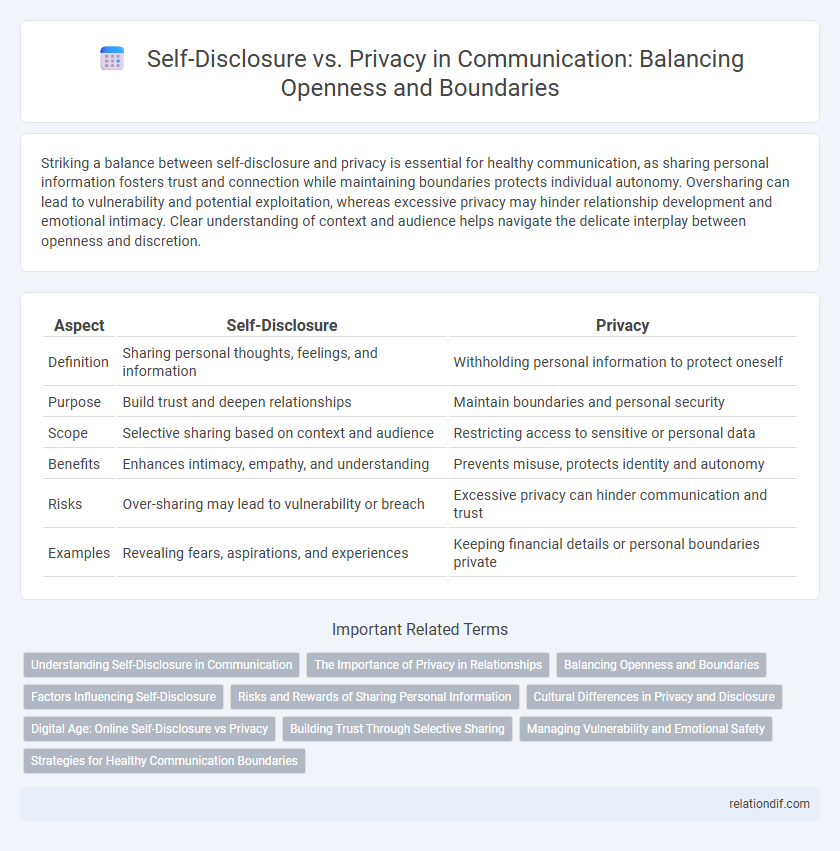Striking a balance between self-disclosure and privacy is essential for healthy communication, as sharing personal information fosters trust and connection while maintaining boundaries protects individual autonomy. Oversharing can lead to vulnerability and potential exploitation, whereas excessive privacy may hinder relationship development and emotional intimacy. Clear understanding of context and audience helps navigate the delicate interplay between openness and discretion.
Table of Comparison
| Aspect | Self-Disclosure | Privacy |
|---|---|---|
| Definition | Sharing personal thoughts, feelings, and information | Withholding personal information to protect oneself |
| Purpose | Build trust and deepen relationships | Maintain boundaries and personal security |
| Scope | Selective sharing based on context and audience | Restricting access to sensitive or personal data |
| Benefits | Enhances intimacy, empathy, and understanding | Prevents misuse, protects identity and autonomy |
| Risks | Over-sharing may lead to vulnerability or breach | Excessive privacy can hinder communication and trust |
| Examples | Revealing fears, aspirations, and experiences | Keeping financial details or personal boundaries private |
Understanding Self-Disclosure in Communication
Self-disclosure in communication involves sharing personal thoughts, feelings, and experiences to build trust and deepen relationships, but it requires careful calibration to avoid compromising privacy. Effective self-disclosure balances openness with discretion, ensuring that shared information is appropriate to the context and the relationship's level of intimacy. Recognizing boundaries and privacy concerns enhances communication by fostering mutual respect and emotional safety between interlocutors.
The Importance of Privacy in Relationships
Maintaining privacy in relationships fosters trust and safeguards emotional boundaries, ensuring individuals feel secure and respected. Clear limits on self-disclosure prevent misunderstandings and help preserve personal autonomy while allowing intimacy to flourish. Balancing openness with discretion is essential for healthy communication and long-term relationship stability.
Balancing Openness and Boundaries
Balancing openness and boundaries in communication involves selectively sharing personal information while protecting sensitive details to maintain trust and respect. Effective self-disclosure fosters deeper connections, but setting clear privacy limits prevents vulnerability and emotional harm. Navigating this balance enhances relational intimacy without compromising individual security or comfort.
Factors Influencing Self-Disclosure
Factors influencing self-disclosure include trust, perceived risks, and cultural norms that shape how openly individuals share personal information. The level of intimacy in relationships and past communication experiences also significantly affect the willingness to disclose sensitive details. Furthermore, individual personality traits such as openness and social anxiety play crucial roles in determining the depth and frequency of self-disclosure.
Risks and Rewards of Sharing Personal Information
Sharing personal information in communication involves balancing the benefits of self-disclosure, such as building trust and fostering intimacy, against risks like vulnerability to judgment, exploitation, or breaches of privacy. Selecting appropriate boundaries helps protect sensitive data while encouraging deeper connections that enhance relationship quality. Awareness of context and audience can mitigate negative consequences while maximizing the emotional rewards of openness.
Cultural Differences in Privacy and Disclosure
Cultural differences significantly shape self-disclosure and privacy norms, influencing how individuals communicate personal information within various societies. In collectivist cultures, such as Japan and China, privacy is highly valued, and individuals tend to disclose less personal information to maintain group harmony and avoid social discomfort. Conversely, individualistic cultures like the United States encourage more open self-disclosure as a means of asserting identity and building personal relationships.
Digital Age: Online Self-Disclosure vs Privacy
Online self-disclosure has significantly increased in the digital age, with users sharing personal information across social media, blogs, and forums to build connections and express identity. However, this openness often compromises privacy, exposing individuals to risks such as data breaches, identity theft, and targeted advertising. Balancing the benefits of digital self-expression with robust privacy protections remains a critical challenge for users and platform developers alike.
Building Trust Through Selective Sharing
Selective self-disclosure fosters trust by revealing personal information strategically while safeguarding privacy boundaries. Sharing experiences and feelings that resonate with others encourages emotional connection without compromising sensitive details. This balance between openness and discretion strengthens relationships and promotes mutual respect in communication.
Managing Vulnerability and Emotional Safety
Effective communication balances self-disclosure and privacy to manage vulnerability and maintain emotional safety. Sharing personal information thoughtfully builds trust while protecting boundaries reduces the risk of emotional harm. Prioritizing mutual respect and emotional awareness enhances openness without compromising individual comfort.
Strategies for Healthy Communication Boundaries
Setting clear personal limits while sharing information fosters trust and reduces misunderstandings in communication. Employing selective self-disclosure based on context and audience ensures privacy protection and emotional safety. Regularly reassessing boundaries and openly discussing comfort levels enhances mutual respect and effective interactions.
Self-disclosure vs privacy Infographic

 relationdif.com
relationdif.com